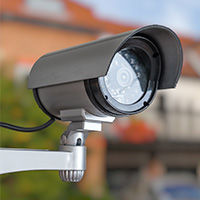While fiber optic ports are becoming increasingly common on networked electronics, the majority of security and access control devices still rely on RJ45 twisted pair connections. To help bridge the copper-fiber divide, media converters and transceiver modules (also known as SFPs or mini-GBICs) are often required.
Media converters effectively convert one “media” format to a different media format — i.e., copper to fiber and vice versa. They can be used in pairs, with one converter on each end of the cable run, or in conjunction with other network-based devices, such as fiber-enabled network switches.
This article explores media converters, the fiber that connects them, and other hardware commonly deployed in fiber-based security and access control applications.
Why Integrate Fiber in Security Applications
Fiber is a natural fit for security and access control applications. Why?
First, fiber extends cable runs. Security cameras in particular are often remotely located and require extended lengths of cable. Twisted pair cable has a length limitation of 330 feet (100m) or less depending on device power and bandwidth. Optical based systems, on the other hand, leverage lasers to send signals 1000ft (300m) on multimode fiber and many miles on single mode fiber.
Second, fiber expands system bandwidth. High-performance twisted pair cables have a maximum bandwidth capability of 10G whereas fiber easily supports 100G+ (in fact, single mode fiber doesn’t have a bandwidth ceiling cap). This isn’t a problem for standard definition cameras; however, 4K cameras can push up to 18G and 8K cameras can push up to 48G. Simply put, twisted pair isn’t designed for ultra high-definition video distribution and monitoring.
Third, fiber is perfect for outdoor and environmentally-sensitive applications. Fiber’s glass construction creates immunity from surges, static, lightning and signal interference even over long and exposed runs. In older buildings, fiber also normalizes different ground planes that can cause image stability and performance issues.
Fourth, fiber is secure. Fiber is inherently resistant to eavesdropping and purposeful interference, as it transmits data using light pulses through glass, making it significantly harder to intercept than the electrical signals transmitted on twisted pair cables. For these reasons, fiber is the preferred choice for highly sensitive data transmission in both the public and private sectors.
Finally, fiber is cost-effective. Surprising to most integrators and building owners, fiber-based infrastructures often cost less than their twisted pair counterparts. Commonly used bulk single mode fiber costs around $0.30 per foot whereas high-quality twisted pair cable can exceed $0.60 or more per foot.
Choosing Fiber Cable and Connectors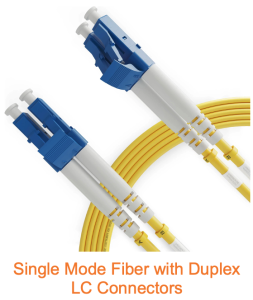
Ultimately, fiber optic cable and connector type is dictated by the connections on the media converter and/or network switch. Thankfully, modern electronics are typically flexible due to swappable transceiver ports that adapt to different cable and connector types.
That said, there are some best practices when selecting interconnects:
First, integrate a cable with at least two optical strands (also known as duplex fiber). Most media converters leverage transceiver modules that feature two connections. The first connection is used to transmit data, and the second connection is used to receive data.
Second, integrate multimode mode fiber for runs under 1000ft (300m) and single mode fiber for runs over 1000ft (300m). Simply put, single mode fiber features a smaller core size that leads to lower attenuation and therefore longer transmission distances and higher bandwidths. The physics are straight forward: a smaller pipe means less signal reflection. Most integrators choose to only integrate single mode fiber because of it’s flexibility, performance and cost.
Third, integrate a cable that’s built for your environment. Fiber optic cables are available in multiple jacket and armoring constructions. When choosing a cable consider whether you’ll need a burial-grade construction, something armored for added protection, or possible a plenum or riser rating for in-wall installation.
Fourth, integrate LC connectors. While older electronics featured a myriad of different connector formats, most modern transceiver modules feature duplex (two strand) LC connections.
Finally, verify your transceiver is compatible with your electronics, cable and connectors. The recommendations above are based on common standards; however, they don’t conform to every device or application. Perhaps your best move is to standardize design and sourcing from a single trusted source.
As an example, the below Future Ready Solutions’ products are compatible and commonly used in security applications:
- Fiber-to-twisted pair media converter (ROBOfiber LFC-1001-SFP)
- 1G single mode transceiver module (LightSpeed SFP-1G-SM20K)
- Riser-rated duplex single mode bulk fiber (Cleerline D29125SMOSR)
- Single mode LC fiber optic connectors (Cleerline SSF-LC-SMUPC-10)
Future Ready Solutions also stocks additional products as required for most applications.
Media Converter to Media Converter Application
Now that we understand why and how to use fiber in security and access control, let’s explore some common applications.
The most frequent application involves extending the connection between a twisted pair-based camera and network switch as shown below. Two fiber-to-twisted pair media converters attach the devices using single mode fiber and LC connectors. The devices gain the benefits of distance, signal integrity, interference isolation and electrical immunity.
The parts list for this application includes:
- 2x fiber-to-twisted pair media converters (ROBOfiber LFC-1001-SFP)
- 2x 1G single mode transceiver modules (LightSpeed SFP-1G-SM20K)
- 1x riser-rated duplex single mode bulk fiber 1000ft spool (Cleerline D29125SMOSR)
- 1x 10-pack of single mode LC fiber optic connectors (Cleerline SSF-LC-SMUPC-10)
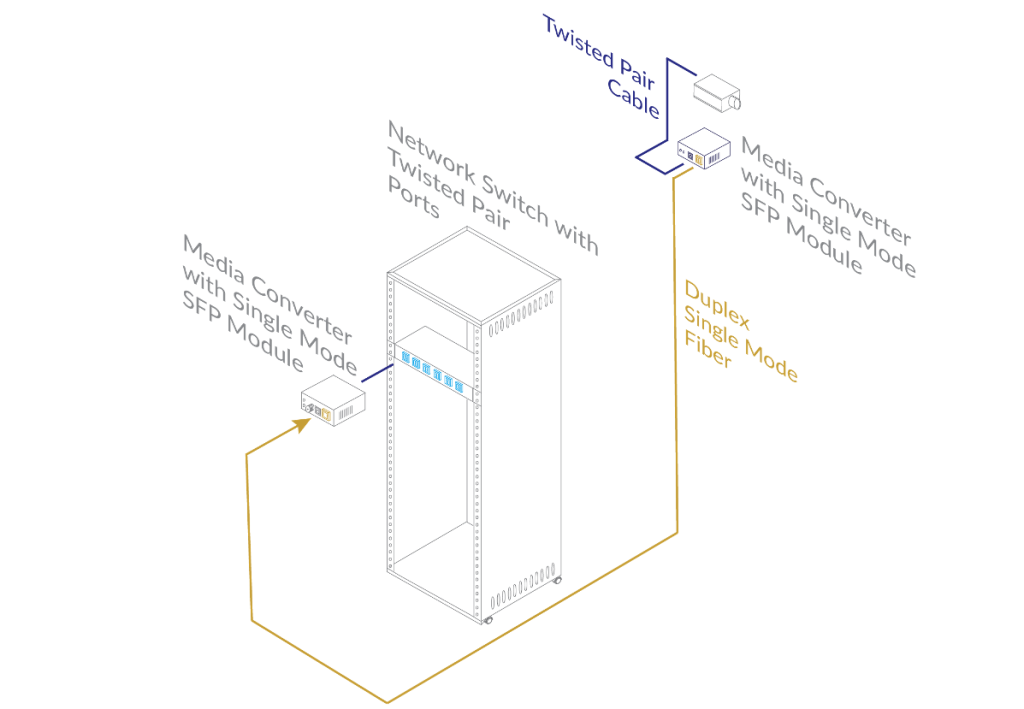
Media Converter to Network Switch Application
A second frequent application involves connecting a fiber-t0-twisted pair media converter directly to a fiber port on a network switch as shown below.
In this application, the network switch connects to to the media converter using single mode fiber and LC connectors. Both the media converter and network switch use matching SFP transceiver modules.
The application also shows an incoming fiber-based internet connection.
The parts list for this application includes:
- 1x fiber-to-twisted pair media converter (ROBOfiber LFC-1001-SFP)
- 1x fiber and twisted pair industrial network switch (ROBOfiber HGW-804SM)
- 2x 1G single mode transceiver modules (LightSpeed SFP-1G-SM20K)
- 1x riser-rated duplex single mode bulk fiber 1000ft spool (Cleerline D29125SMOSR)
- 1x 10-pack of single mode LC fiber optic connectors (Cleerline SSF-LC-SMUPC-10)
- 1x FTTx outdoor demarcation enclosure (LightSpeed FTTX-NID-150)
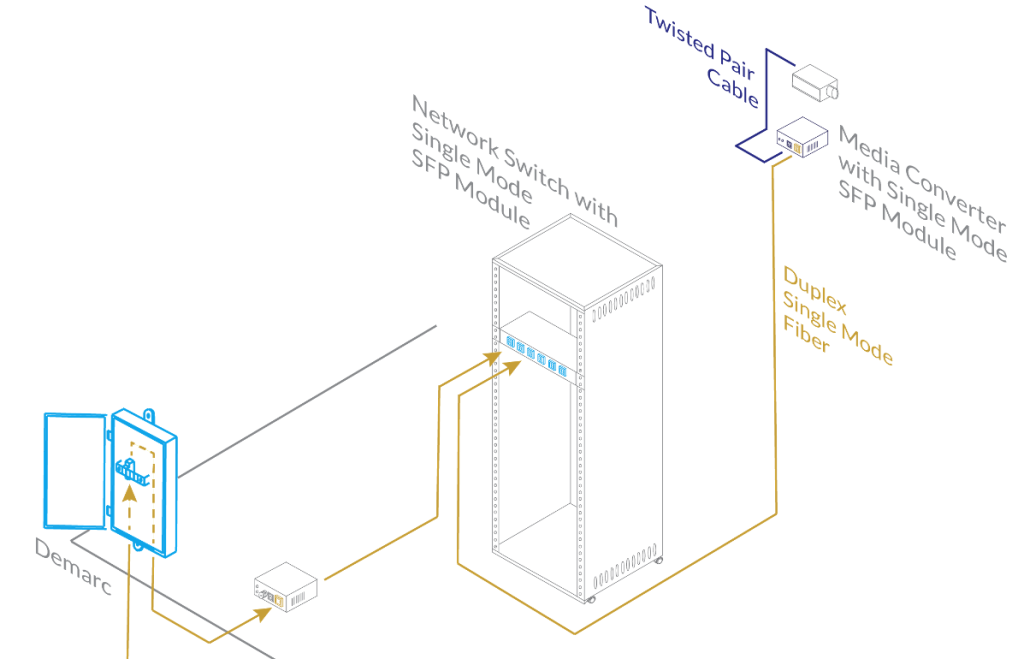
Media Converter to Extended Network Switch Application
A third frequent application involves connecting a fiber-t0-twisted pair media converter directly to a fiber port on a network switch over an extended distance as shown below.
In this application, the network switch connects to to the media converter using single mode fiber and LC connectors; however, the cable run passes through two outdoor enclosures that transition the cable from indoor riser to outdoor direct burial. Cable transitions are common in security applications, as cameras are often located outdoors or in remote locations.
As with the previous application, both the media converter and network switch use matching SFP transceiver modules, and an incoming fiber-based internet connection is present.
The parts list for this application includes:
- 1x fiber-to-twisted pair media converter (ROBOfiber LFC-1001-SFP)
- 1x fiber and twisted pair industrial network switch (ROBOfiber HGW-804SM)
- 2x 1G single mode transceiver modules (LightSpeed SFP-1G-SM20K)
- 1x riser-rated duplex single mode bulk fiber 1000ft spool (Cleerline D29125SMOSR)
- 1x direct-burial two strand single mode bulk fiber 1000ft spool (Cleerline 2ACS9125OS2PE-1000)
- 2x 10-pack of single mode LC fiber optic connectors (Cleerline SSF-LC-SMUPC-10)
- 2x outdoor hybrid LGX fiber enclosures (LightSpeed FTTX-NID-LGX)
- 2x hybrid LGX fiber panels (LightSpeed FTTX-LGX-MIXED)
- 1x FTTx outdoor demarcation enclosure (LightSpeed FTTX-NID-150)
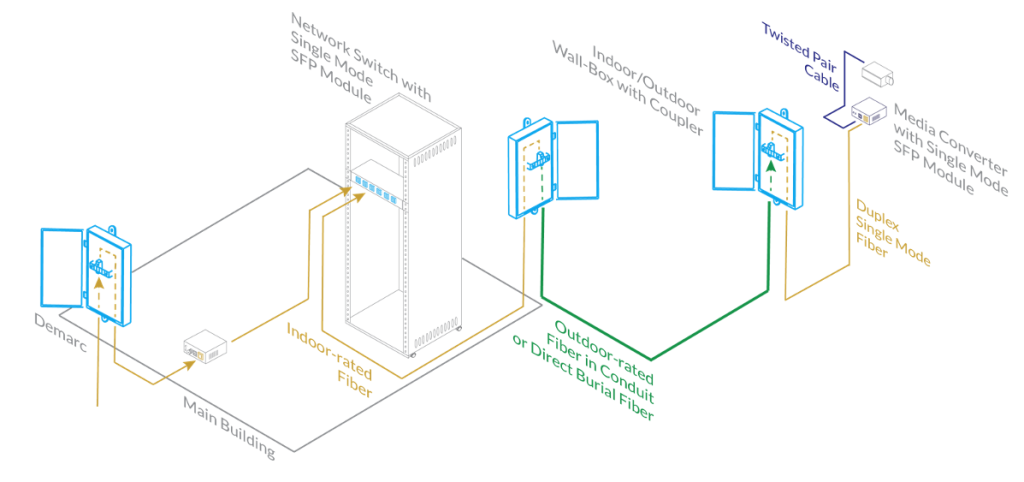
Final Notes and Product Selection
Media converters are available in a variety of formats with different capabilities. ROBOfiber, a leader in the category, offers models for 1G, 10G and even for multiple twisted pair connections. A list of products is available on the Future Ready Solutions website.
ROBOfiber also offers industrial network switches and other fiber-based signal management solutions.
No matter what product you choose, keep in mind fiber-based electronics require local power for proper operation. Fiber optic cable does not transmit PoE or other voltage — that’s what makes it perfect for EM, RF, static and surge immunity.
Additional information on the products and applications discussed above is available from Future Ready Solutions.

